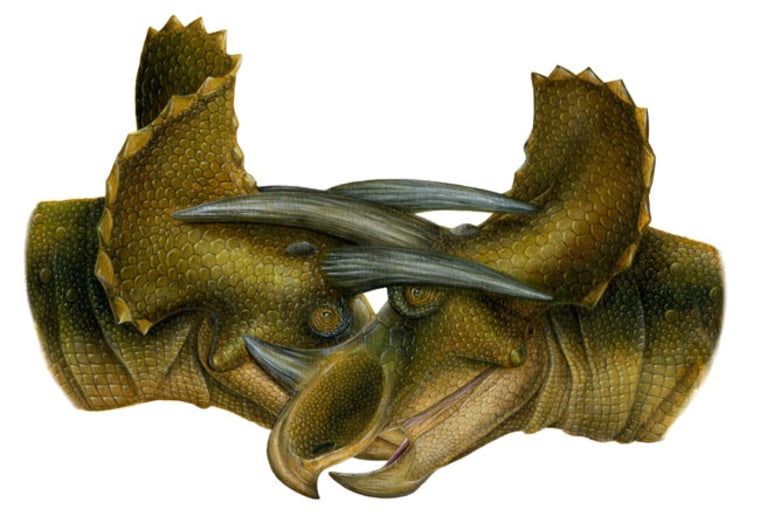About 100 million years ago, Triceratops likely engaged in horn-to-horn battles with its kin, according to a new analysis of the scrapes, bruises and healing fractures preserved on fossils of the dinosaurs' bony headgear.
"Paleontologists have debated the function of the bizarre skulls of for years now," said lead study researcher Andrew Farke, curator at the Raymond M. Alf Museum of Paleontology in California. "Some speculated that the horns were for showing off to other dinosaurs, and others thought that the horns had to have been used in combat against other horned dinosaurs. Unfortunately, we can't just go and watch a Triceratops in the wild."
Past research has also suggested served as a and species recognition.
The results from Farke's new study point to combat as one usage.
"We're not suggesting Triceratops was using its horns only for fighting," Farke told LiveScience. "I like to think of the horns on these animals as kind of like the Swiss Army knives of the dinosaur world. They were using their horns for a variety of functions."
Horn patterns
Farke and his colleagues analyzed from hundreds of fossils belonging to Triceratops and Centrosaurus.
Both dinosaurs belong to the family Ceratopsidae, but while Triceratops sported two long horns above its brows and a shorter one topping its beak-like snout, Centrosaurus had two smaller brow horns and a longer one on its nose. Both dinosaurs were equipped with a bony frill around their necks.
With such different horn patterns, the researchers assumed that if the dinosaurs were horn-butting with members of their own species the injuries of Triceratops and Centrosaurus should also be different from each other. But if they weren't poking and butting one another with those horns, the injuries should be relatively similar, perhaps due to random nicks from clumsily running into a tree or head butts from predators, Farke said.
Triceratops combat
The team found the so-called squamosal bone on the skull that forms part of the frill was injured 10 times more frequently in Triceratops compared with Centrosaurus. "The most likely culprit for all of the wounds on Triceratops frills was the horns of other Triceratops," Farke said. The combat would have been similar to that among modern antelopes and among deer.
Farke's previous research showed that if Triceratops were engaging in with other Triceratops, the squamosal bone would be an area most frequently injured.
With Centrosaurus showing so few bony injuries, the researchers are unsure if this dinosaur fought with its horns.
"Possibly Centrosaurus wasn't using its horns for fighting, or if it was doing this, it was concentrating its energies on parts away from the skull, like maybe flank-butting or something like that," Farke said.
The study, detailed in the Jan. 28 issue of the online journal PLoS ONE, was funded in part by the National Science Foundation.
